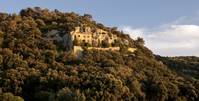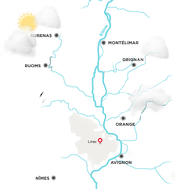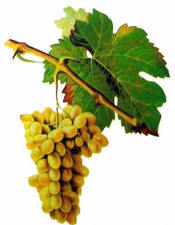I’m the road this week in the Rhône Valley, a land that has held sway for me for years ever since I took a road trip through the region as a university student. There’s just something that makes my heart swoon when seeing fields of lavender, sunflowers, and vineyards for miles peppered with little stone houses dawning blue doors and window shutters. Of course, back then, I had no understanding of wine. So when the association representing Rhône Valley Wines offered an invitation to join them on a road trip  through both the southern and northern parts of the region, stopping at as many Cru appellations as possible along the way, I jumped at the chance.
through both the southern and northern parts of the region, stopping at as many Cru appellations as possible along the way, I jumped at the chance.
With only a few days of the week-long tour under my belt, I can hardly give a full overview of the experience. I’ve managed to savor some of the regional cuisine, make a stop at the Pont du Gard in Nimes, take a dip in the pool at hotel Domaine Du Clos, and embrace the almost deafening rattle of les cigales (cicadas) throughout the heat of the day. In fact, I’ve come to find it strangely comforting.
Regarding wine, I think it’s safe to say there’s a lot about the Rhône Valley that people are familiar with, i.e., red wine made from a blend of predominantly Grenache, Syrah, and Mourvedre (as well as a few other varieties), the warm Mediterranean climate, the famous "Le Mistral wind," and of course, the iconic Châteauneuf-du-Pape cru (an appellation that has afforded near royal status for its powerful Grenache-dominant blends). In fact, while the wines are indeed special, this hallowed Rhône Valley cru has received so much limelight that the remaining 16 cru of the region are often left lurking in the shadowed periphery. Sure, many of us have a vague awareness of Gigondas, Tavel, Vacqueyras, and even Rasteau and Beaumes-de-Venise…but there are still 11 more!
If it makes you feel any better, aside from memorizing a list of all of them for wine certification examinations, I wasn’t very familiar with them  either. So, imagine my surprise to spend a morning walking around the vineyards of Lirac–a Cru appellation situated directly across the Rhône river from Châteauneuf-du-Pape–to find a region producing red blends just as impressive as many wines on the other side of the water.
either. So, imagine my surprise to spend a morning walking around the vineyards of Lirac–a Cru appellation situated directly across the Rhône river from Châteauneuf-du-Pape–to find a region producing red blends just as impressive as many wines on the other side of the water.
With more than 730 hectares cultivated over the four little villages of Roquemaure, Saint-Laurent-des-Arbres, Saint-Genies-de-Comolas, and Lirac, the appellation grows most of the same varieties found in its neighboring commune on the left bank. Grown amongst same galet des roules “soils” (the reddish round river stones deposited from the Rhône River centuries ago), and brushed by the same abrasive Mistral (that helps blow humidity from the vines and keep fungal disease pressure low), the red wines of Lirac can be just as powerful and intriguing as those from Châteauneuf-du-Pape. In addition to that important finding, there are a few other take-aways I’ll carry with me from Lirac.
Les Galets Roules Have Company
Lauded for the unique heat protection and mineral rich chemistry, the galets roules are indeed a unique soil type for varieties like Grenache (assuming that you can understand “soil” as including really big rocks rather than dirt…). And while Lirac draws quite a bit of its particularity from its proximity to the Rhône River’s rocks, it also has two other unique soils up its sleeve. The first are sandy soils along some of the region’s terraced slopes, soils that produce red wines that are finer and with less tannin. The second is a rocky, limestone-rich soil type that produces red wines with stronger tannins and higher acidity.
White is the New Red
While most people associate Côtes du Rhône wines as being red, it’s important to note that white wine is also prolific in the region. In particular, Lirac excels at white wine made from grapes such as Grenache Blanc, Viognier, Bourboulenc, Roussanne, and Clairette. While the red wines shine in terms of structure, concentrated fruit, and a delicious earthiness, white wines in Lirac are particularly unique in that they tend to show beautiful floral and stone fruit aromas along with a great vibrancy from the calcium-rich limestone soils in which they are typically grown. While some white wines of Southern France have been saddled with a reputation for being broad and a little flabby on the palate, the white wines of Lirac are elegant, with a hypnotic balance of tension and a touch of phenolic bitterness. These are excellent wines to enjoy with food.
Clairette Is Where It’s At
Clairette in particular is a dark horse variety rarely talked about in the States. While often lumped into a long list of white grapes often grown  throughout the Côtes du Rhône, for many winemakers in Lirac, Clairette is one to be revered. It’s a white grape that makes beautifully elegant white wines when used as the predominant grape for a blend. (You can also find single variety Clairette from producers such as Château de Montfaucon.) It is a grape admired for its elegant florality, notes of orange blossom, almond paste, and a surprisingly vibrant minerality, drawn from the limestone-rich soils.
throughout the Côtes du Rhône, for many winemakers in Lirac, Clairette is one to be revered. It’s a white grape that makes beautifully elegant white wines when used as the predominant grape for a blend. (You can also find single variety Clairette from producers such as Château de Montfaucon.) It is a grape admired for its elegant florality, notes of orange blossom, almond paste, and a surprisingly vibrant minerality, drawn from the limestone-rich soils.
You Can’t Beat the Value
While you would be hard-pressed to find an average Châteauneuf-du-Pape for anything lower than $50, the wines of Lirac are decidedly less expensive ringing up for about $20 to $30. What better value can you get from quality wine made from some of very same soil types as in Châteauneuf-du-Pape…along with white wines made in soils similar to those found in calcium-rich regions such as Chablis and Vouvray?
Though it’s true I only spent less than a day in the appellation, it became clear very quickly that there’s a lot more to Lirac that’s worth exploring. Although it’s doubtful I’ll have a chance to traipse around in the vineyards and soils again in the near future, I’ll surely do my best to explore what I can sample from bottles as soon as I touch ground back home….
